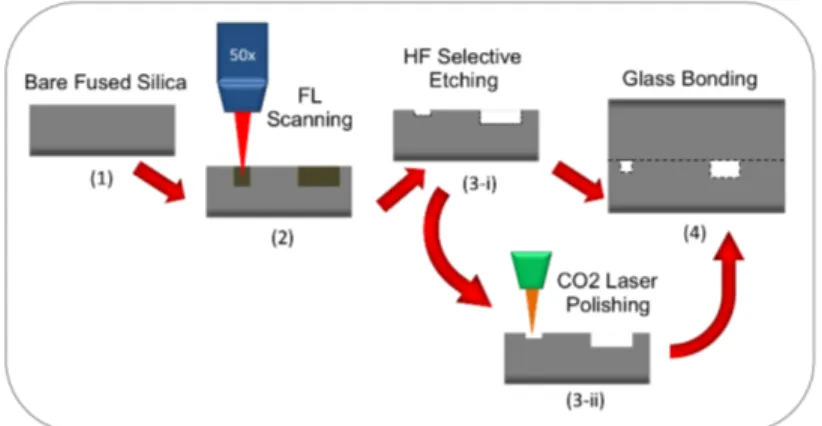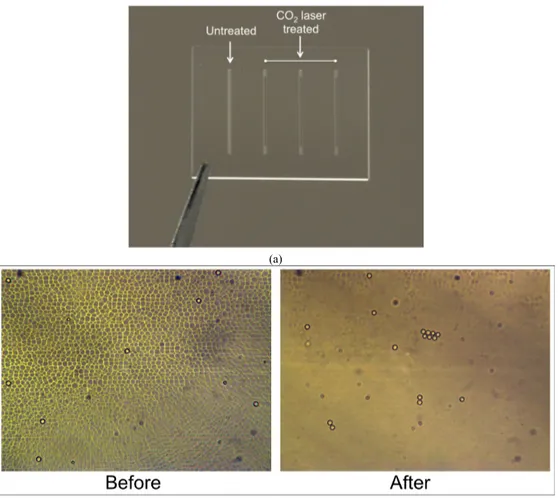STh4K.5.pdf CLEO:2016 © OSA 2016
CO2 polishing of femtosecond laser micromachined
microfluidic channels
Murat Serhatlioglu1, Bulend Ortac1, Caglar Elbuken1, Necmi Biyikli1, Mehmet E. Solmaz2*
1UNAM - National Nanotechnology Research Center, Bilkent University, Ankara, Turkey 2Department of Electrical and Electronics Engineering, Izmir Katip Celebi University, Izmir, Turkey
*mehmete.solmaz@ikc.edu.tr
Abstract: The CO2 polishing of femtosecond laser micromachined channels is studied. The surface quality before and after polishing is observed with naked eye and optical microscope. The method improves imaging of microspheres.
OCIS codes: (220.5450), (140.3390)
1. Introduction
Femtosecond laser micromachining is a precise fabrication method for micron-scale fused silica samples [1]. Due to its inherent properties, the surface roughness on fused silica is on the order of hundreds of nanometers. Recently, there have been efforts to introduce CO2 laser processing to the femtosecond laser micromachined surfaces to reflow the glass material and create new shapes [2, 3]. Here we report surface roughness improvement of fused silica surfaces using low-power CO2 treatment. We also show the application of such treatment to a microfluidic channel to attain better imaging quality of microspheres.
2. Fabrication
The fabrication process of CO2 treatment on fused silica samples is shown in Figure 1. A custom femtosecond laser micromachining setup was built for fabrication of 400µm wide and 100µm deep microfluidic channel in fused silica. Microfluidic channels were first irradiated using a femtosecond laser with 1kHz repetition rate, ~150fs pulse width, and 1µJ pulse energy. The scanning speed was 100µm/sec and 50X microscope objective was used for focusing. The surface channels were revealed after 1 hour in 15% hydrofluoric acid.
For CO2 treatment of fused silica, we used CO2 laser system from Epilog lasers. The power used was 2W with 6mm/sec scan speed and 5kHz repetition rate. The laser was used in Raster Scan mode with 1000dpi resolution. Only buried surfaces (bottom of the channels) were treated. The channels were sealed with another fused silica piece in a 700°C oven via thermal bonding.
Fig. 1. The process showing CO2 polishing of femtosecond laser micromachined surfaces. 3. Results
The CO2 treated channels show a clear improvement with naked eye compared to the untreated channel (Fig. 2a). The opaque appearance of the untreated channel is a direct consequence of femtosecond laser micromachining. The microfluidic channels were connected to a peristaltic pump and 8µm polystyrene particles were flowed. An inverted microscope with a 10X objective reveals the difference between imaging quality of microfluidic surfaces before and after CO2 treatment (Fig. 2b). The island shaped surface structures are smoothed out due absorption and reflow of glass material at 10.6µm wavelength. It is important to note that only the bottom surface of the channel was exposed
STh4K.5.pdf CLEO:2016 © OSA 2016
to CO2 laser. Treating the outer regions with CO2 laser may cause difficulty in glass-to-glass bonding due to reflow of glass. Future work should include using a higher magnification lens for CO2 laser to reach much smaller channels.
(a)
(b)
Fig. 2. a) CO2 treated and untreated microfluidic channels before thermal bonding. Treated channels show a clear improvement in terms of
transparency; b) Microscope images of polystyrene microspheres in the microfluidic channel before and after CO2 laser treatment. 4. Acknowledgement
This work was supported by The Scientific and Technological Research Council of Turkey (TUBITAK) under grant no. 113E321.
5. References
[1] Y. Bellouard, A. Said, M. Dugan, and P. Bado, "Fabrication of high-aspect ratio, micro-fluidic channels and tunnels using femtosecond laser pulses and chemical etching," Opt. Express, vol. 12, pp. 2120-2129, 05/17 2004.
[2] C. Kim, I.-B. Sohn, Y. J. Lee, C. C. Byeon, S. Y. Kim, H. Park, et al., "Fabrication of a fused silica based mold for the microlenticular lens array using a femtosecond laser and a CO 2 laser," Optical Materials Express, vol. 4, pp. 2233-2240, 2014.
[3] J. Drs, T. Kishi, and Y. Bellouard, "Laser-assisted morphing of complex three dimensional objects," Optics express, vol. 23, pp. 17355-17366, 2015.

